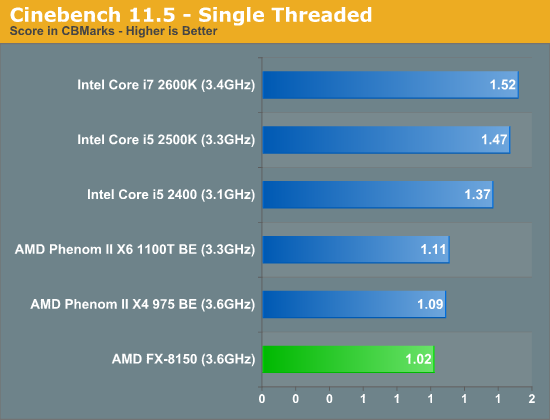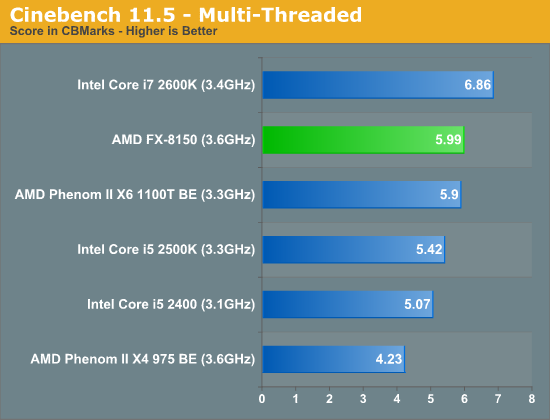Try and have an open mind.
Bulldozer's single core IPC is currently @ a 28-33 percent deficit to SB single core IPC depending on the SB clock-speed. According to this benchmark done by Anandtech in CB 11.5.

BD also appears to be currently slower in single threading (less than 10 percent) when it comes to a comparison to its older architecture of the later higher end Phenom II generation.
And in Multi-Threading SB shares a 12-13Percent speed advantage currently with the 2600k.

I don't believe these are as huge as deficits as people on these forums complain on and on about. In fact I think they are minor and will be solved shortly. Now getting to my points. SB came out in February, BD came out in Oct this year. They are both the leading cutting edge technology from each respective company. They will both have a 22nm die shrink when the time comes in Ivy Bridge and BD3 Steamroller.
When I look at Intels gameplan of i7's always being Quad Core at best with Quad Hyperthreading Cores to equal 8 Cores, and AMD now using 4 Compute Units/Modules to equal it's 8 Cores. I still think AMD's architecture has far more room to grow where Intel can't really innovate until they change their architecture (Hyperthreading seems a waste of an architecture design compared to AMD's Compute Units/Modules) and their 3D transistors basically provide better power consumption.
Intel is on their 2nd gen i7's currently, but their cores and Hyperthreading remain the same. Seems to me they are relying on clock-speeds instead of any architecture improvements. People think the 3D transistor will change the game, maybe it will and maybe it will solely lower power consumption, which seems to be the case it will be sensitive to power states and shut off more unused transistors than in the past.
Where as AMD's Bulldozer can make advancements in so many areas, with their L2 cache (latency/balancing/fetching) Picks an invalid way before picking a valid way alleged problems?, MSR/APC registers optimizing, OS support, Interrupt Delivery/Handling, etc. This is a big part of AMD's future (fine tuning this CPU) I think the yields were low and now that AMD has gotten them up and running out the door they will continue to fine tune these chips, and be experimenting alot more. I see them exploiting this chips design architecture in amazing ways in the future. I see Intel shrinking and saving power lol! In fact I see Intel stealing AMD's design shortly.
Does anyone else think we might ever see a Windows OS that is optimized for AMD CPU's?
But the main question I have for you fellow techies is which CPU will transcend further in that time Intels or AMD's and why you think so? (I know the future is unwritten, but this is fun and I think the CPU wars are finally starting)
I personally see BD being optimized in this 1st/2nd generation and then blowing up into a mega beast CPU by 22nm if not before this point in time. I even see the BD3 Steamrolller being just that, it is when AMD will pick up Steam and blow Intel CPU's away for good
Let's try and keep this thread civil and intelligent guys.
Bulldozer's single core IPC is currently @ a 28-33 percent deficit to SB single core IPC depending on the SB clock-speed. According to this benchmark done by Anandtech in CB 11.5.

BD also appears to be currently slower in single threading (less than 10 percent) when it comes to a comparison to its older architecture of the later higher end Phenom II generation.
And in Multi-Threading SB shares a 12-13Percent speed advantage currently with the 2600k.

I don't believe these are as huge as deficits as people on these forums complain on and on about. In fact I think they are minor and will be solved shortly. Now getting to my points. SB came out in February, BD came out in Oct this year. They are both the leading cutting edge technology from each respective company. They will both have a 22nm die shrink when the time comes in Ivy Bridge and BD3 Steamroller.
When I look at Intels gameplan of i7's always being Quad Core at best with Quad Hyperthreading Cores to equal 8 Cores, and AMD now using 4 Compute Units/Modules to equal it's 8 Cores. I still think AMD's architecture has far more room to grow where Intel can't really innovate until they change their architecture (Hyperthreading seems a waste of an architecture design compared to AMD's Compute Units/Modules) and their 3D transistors basically provide better power consumption.
Intel is on their 2nd gen i7's currently, but their cores and Hyperthreading remain the same. Seems to me they are relying on clock-speeds instead of any architecture improvements. People think the 3D transistor will change the game, maybe it will and maybe it will solely lower power consumption, which seems to be the case it will be sensitive to power states and shut off more unused transistors than in the past.
Where as AMD's Bulldozer can make advancements in so many areas, with their L2 cache (latency/balancing/fetching) Picks an invalid way before picking a valid way alleged problems?, MSR/APC registers optimizing, OS support, Interrupt Delivery/Handling, etc. This is a big part of AMD's future (fine tuning this CPU) I think the yields were low and now that AMD has gotten them up and running out the door they will continue to fine tune these chips, and be experimenting alot more. I see them exploiting this chips design architecture in amazing ways in the future. I see Intel shrinking and saving power lol! In fact I see Intel stealing AMD's design shortly.
Does anyone else think we might ever see a Windows OS that is optimized for AMD CPU's?
But the main question I have for you fellow techies is which CPU will transcend further in that time Intels or AMD's and why you think so? (I know the future is unwritten, but this is fun and I think the CPU wars are finally starting)
I personally see BD being optimized in this 1st/2nd generation and then blowing up into a mega beast CPU by 22nm if not before this point in time. I even see the BD3 Steamrolller being just that, it is when AMD will pick up Steam and blow Intel CPU's away for good
Let's try and keep this thread civil and intelligent guys.
![[H]ard|Forum](/styles/hardforum/xenforo/logo_dark.png)